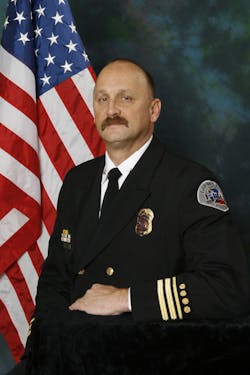It’s 11:30 p.m. and the rain is coming down in sheets. A driver attempting to maneuver a vehicle in these conditions hydroplanes and strikes a power pole, taking it down. The impact from the pole causes the vehicle to flip, and it is now lying upside-down in a ditch. With downed power lines and the possibility of raw fuel or other hazardous liquids leaking from the vehicle, a good scene size-up should help you determine how many people were in the vehicle? Are people trapped? Have people been ejected from the vehicle?
You and your crew arrive on the scene along with other emergency responders. The on-scene vehicles and emergency warning lights could create visual challenges. The flashing lights are a warning for other motor vehicles approaching the scene, but they might hinder you when trying to quickly assess the situation. Your thermal imager (TI) could be the tool for this situation.
Imagers at MVAs
We don’t often think of thermal imaging as the first tool to be used on a motor vehicle accident (MVA) call, but with the conditions described above, the TI could be a powerful tool you could deploy. Your concerns are not only for the victims of this crash scene, but also for the safety of your personnel. Scene size-up with so many distractions can be challenging.
How can the TI help? It could define any downed power lines and detect lighter-than-water liquids that float on the top of a surface. Your TI could define the distance of liquid flowing from the crash site that needs to be contained and could help pinpoint possible vehicle leaks and the potential danger of the vehicle igniting. Once the outside scene has been assessed, you can move inside the vehicle and check for occupied hot seats to aid in determining how many potential victims you need to confirm. Although not an absolute confirmation, the imager will give you many additional reference points that your eyes would be challenged to identify.
Departments train many hours for MVA situations like the complex extrication described above, but what about the scenarios that firefighters might not train for?
Searching capabilities
Let’s take a look at how a TI can help firefighters search for lost victims not involved in a fire situation. Many fire departments don’t spend time training in this area simply because it’s not a frequent call. But it is important.
We have heard the news stories and seen the reports of missing Alzheimer’s patients, Amber and Golden Alerts, and hunters and fishermen lost, just to mention a few. Communities unite together with volunteers participating in the search efforts being led by their local emergency responders to find these missing people. Sometimes these searches result in finding the lost victims and, sadly, sometimes these searches result in tragic endings.
We recognize that a TI can be one of the tools in search and rescue activities; however, without search and rescue training, firefighters might make the wrong assumptions when using the TI as a search tool. Weather, time of year, victims’ clothing, terrain, and daytime versus nighttime conditions are just a few of the issues that can impact how you interpret your TI’s feedback.
One department recently learned in a TI training session that an animal can be misidentified as a human form on the imager. Just because you see a white-hot image on the screen while looking in a wooded area does not automatically mean you are seeing a person. Hide and Seek, the game you played as a child, is actually a great way to improve thermal imaging interpretation capabilities. Creating a “What If?” training scenario that requires personnel to execute as if they were responding to a real call can dramatically increase potential for having a successful outcome.
Training time
Where and how many TIs should be deployed? What is the range for body recognition and signs, such as tracks in the snow at night? The list of questions is almost endless and needs to be explored by training. These types of training exercises could improve your department’s skills when using a TI in search scenarios and will facilitate some new and refreshing activities to complete in your training sessions.
About the Author

Carl Nix
Carl Nix is a 30-year veteran of the fire service. He is currently the battalion chief of the Grapevine, TX, Fire Department, an adjunct instructor for North Central Texas College and a Thermal Imaging instructor for Bullard. Nix holds a bachelor’s degree in fire administration and serves as a guest instructor for Texas A&M Engineering Extension Service’s (TEEX) annual fire training in Texas. He can be reached at [email protected].
